Construction of minimal DFA and cross product of DFA
Information on this page based on:
YouTube: Theory Of Computation 3, Construction of DFA and cross product of DFA
YouTube: Theory Of Computation 4, DFA and problem
- Construct a minimal DFA that accepts set of all strings over {a,b} in which number of a's and b's are even
ω ∊ {a,b} and na(ω) mod 2 = 0 && nb(ω) mod 2 = 0
L = {ε,aa,bb,aabb,abab,baba,aaaa,bbbb,...}
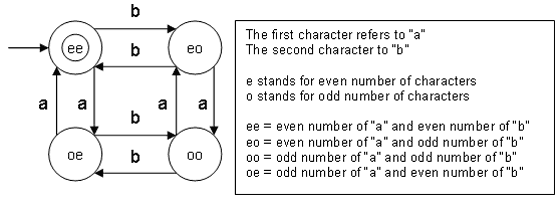
Notes:
- ε is a string of length 0 and does satisfy condition na(ω) mod 2 = 0 and nb(ω) mod 2 = 0
- The language L is infinite, we do not know if the FA is finite or infinite.
By drawing the FA diagram there are a finite number of states which means this minimal DFA is finite.
- na(ω) mod 2 = 0 can also be written as na(ω) 0 (mod 2).
nb(ω) mod 2 = 0 can also be written as nb(ω) 0 (mod 2).
The symbol ≅ means congruent.
- The strings are divided in four classes: "ee", "eo", "oe" and "oo".
- This minimal DFA has 4 states and state "ee" (also referred as q0) is the final state.
- Construct a minimal DFA that accepts set of all strings over {a,b} in which number of a's and b's are even using cross product
ω ∊ {a,b} and na(ω) mod 2 = 0 && nb(ω) mod 2 = 0
Counting a's
L = {ε,aa,aaaa,aaaaaa,...}
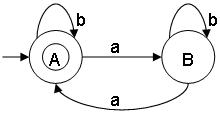
Counting b's
L = {ε,bb,bbbb,bbbbbb,...}
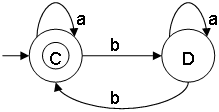
Cross product (combining a's and b's)
Multiply the states {A,B} with {C,D}: {A,B} x {C,D} = {AC,AD,BC,BD}
The cross product consists of 4 states.
In counting a's, state A is the initial state.
In counting b's, state C is the initial state.
AC is the initial state of the 4 states.
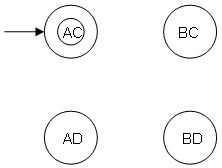
Determine the transition for each state (AC,AD,BC,BD) and for each input (a,b)
- State AC and input a
Counting a's DFA diagram: A -> a -> B
Counting b's DFA diagram: C -> a -> C
Result: AC-> a -> BC
- State AC and input b
Counting a's DFA diagram: A -> b -> A
Counting b's DFA diagram: C -> b -> D
Result: AC-> b -> AD
- State BC and input a
Counting a's DFA diagram: B -> a -> A
Counting b's DFA diagram: C -> a -> C
Result: BC-> a -> AC
- State BC and input b
Counting a's DFA diagram: B -> b -> B
Counting b's DFA diagram: C -> b -> D
Result: BC-> b -> BD
- State BD and input a
Counting a's DFA diagram: B -> a -> A
Counting b's DFA diagram: D -> a -> D
Result: BD-> a -> AD
- State BD and input b
Counting a's DFA diagram: B -> b -> B
Counting b's DFA diagram: D -> b -> C
Result: BD-> b -> BC
- State AD and input a
Counting a's DFA diagram: A -> a -> B
Counting b's DFA diagram: D -> a -> D
Result: AD-> a -> BD
- State AD and input b
Counting a's DFA diagram: A -> b -> A
Counting b's DFA diagram: D -> b -> C
Result: AD-> b -> AC
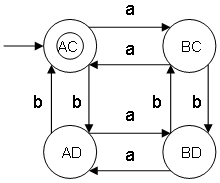
For each state add ee,eo,oe and ee:
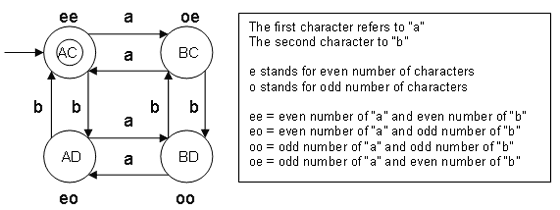
| e |
and |
e |
{ee} |
| e |
and |
o |
{eo} |
| o |
and |
e |
{oe} |
| o |
and |
o |
{oo} |
| e |
or |
e |
{ee,eo,oe} |
| e |
or |
o |
{ee,eo,oo} |
| o |
or |
e |
{ee,oe,oo} |
| o |
or |
o |
{oe,eo,oo} |
If counting a's DFA diagram has m number of states and counting b's DFA diagram has n number of states
the cross product m x n will have mxn states.
|





